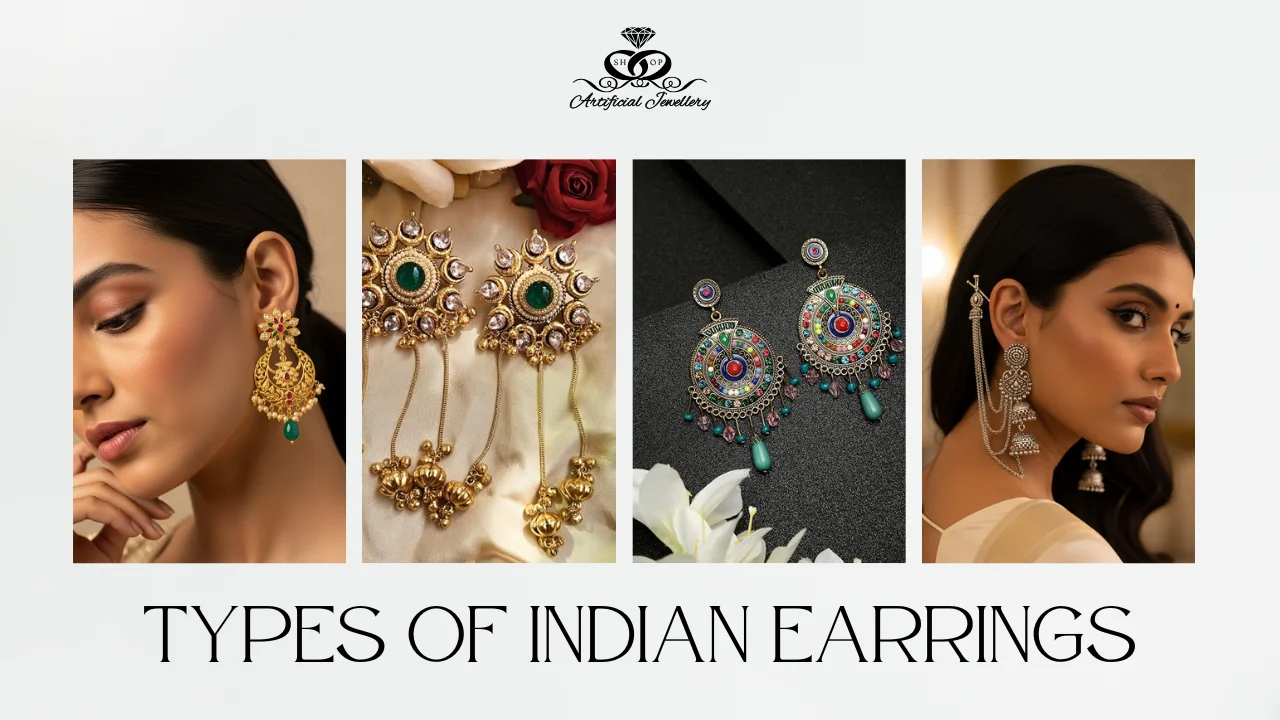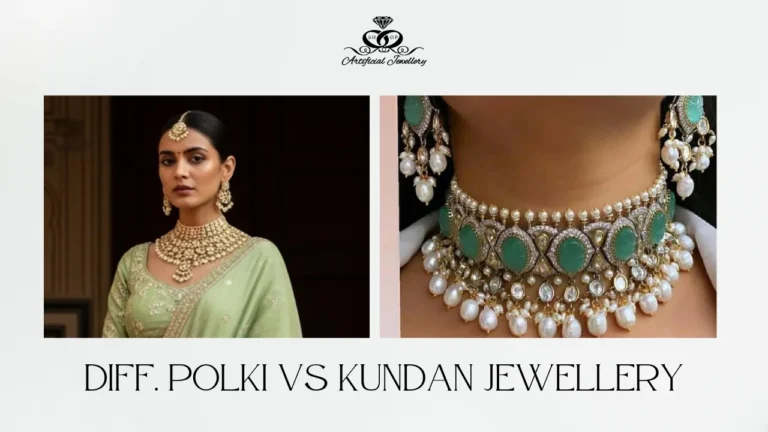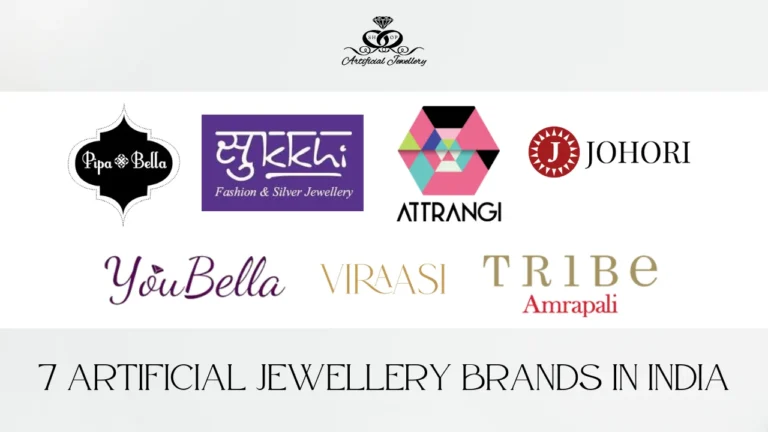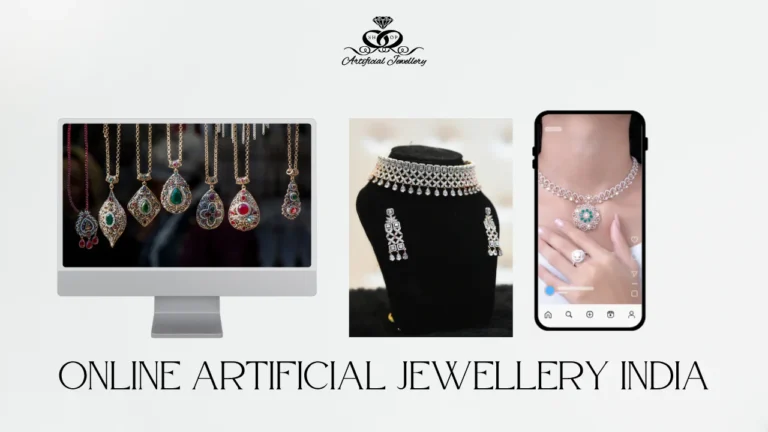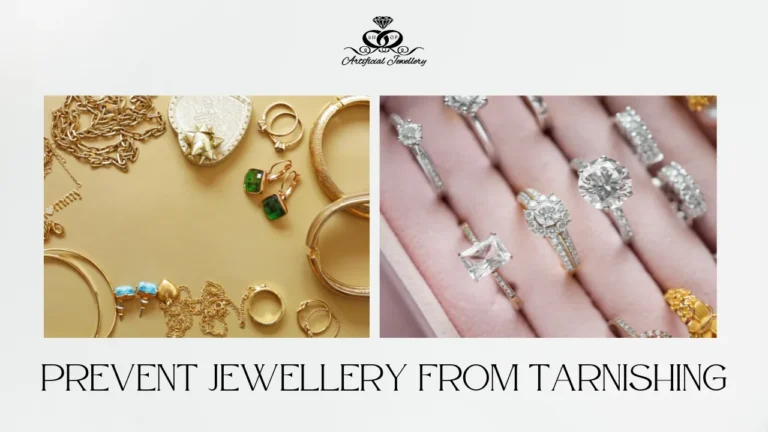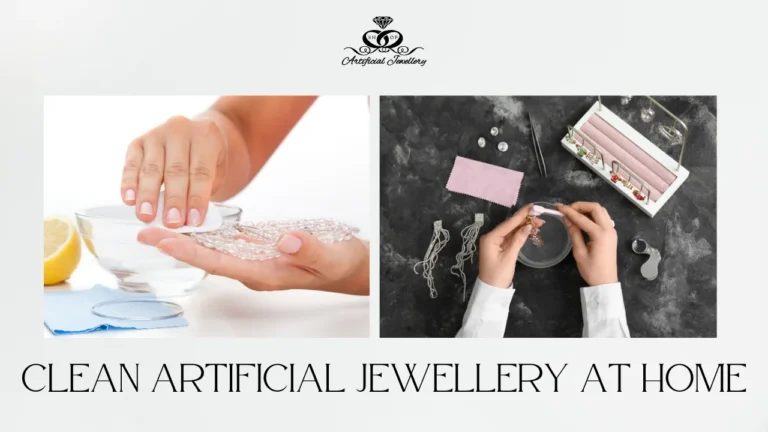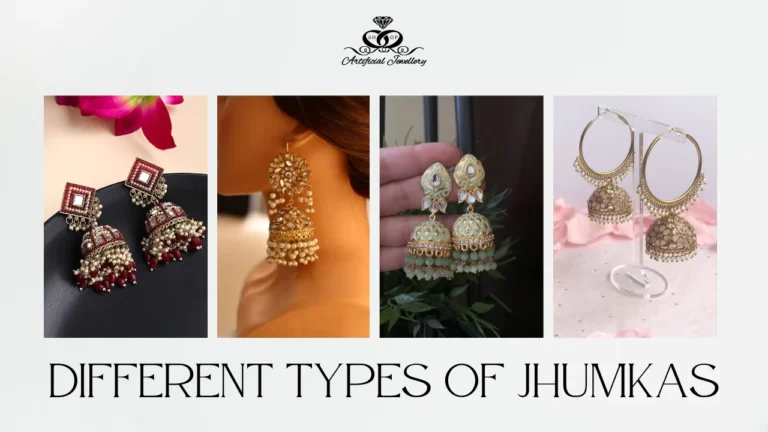Indian earrings are more than just accessories; they are a vibrant tapestry woven with centuries of history, culture, and artistry. From ancient traditions to contemporary fashion statements, earrings have always held a significant place in Indian attire, symbolizing beauty, status, and heritage.
The diversity in design and craftsmanship across India’s myriad regions means there’s an earring for every occasion, every outfit, and every story.
Whether you’re a bride selecting wedding jewelry or a fashion enthusiast building an ethnic wardrobe, understanding the types of Indian earrings helps make informed choices. This guide explores India’s diverse earring heritage – from regional specialties to contemporary designs – along with practical styling advice for different face shapes and occasions.
Types of Indian Earrings by Style/Design
A. Stud Earrings (Karanphool/Karanphool Jhumka)
Simple yet elegant, stud earrings are a timeless classic in Indian jewelry, offering understated sophistication. They often feature intricate floral or geometric designs, sometimes referred to as ‘Karanphool’ (ear flower) due to their resemblance to a blooming blossom. These versatile pieces are perfect for adding a subtle touch of traditional elegance to any look.
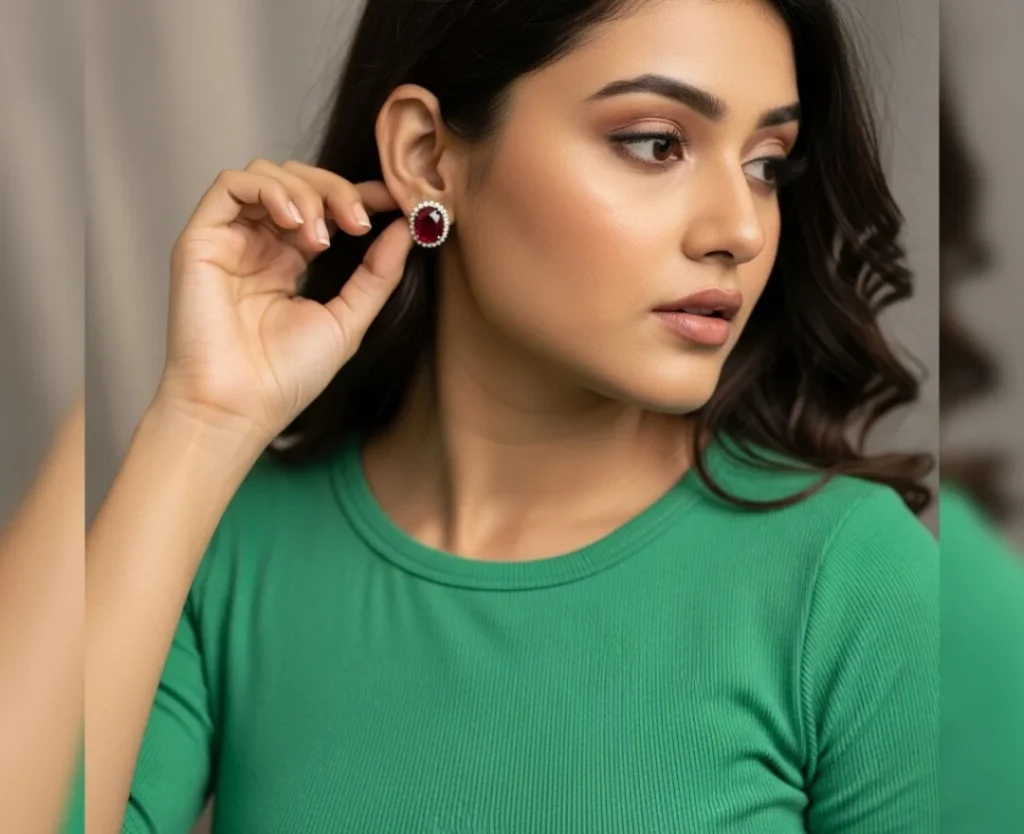
Karanphool studs can range from delicate, everyday wear to more elaborate designs adorned with small pearls or precious stones. Their secure fit makes them comfortable for prolonged use, making them a popular choice across all age groups. They seamlessly blend traditional aesthetics with modern wearability.
B. Drop/Dangler Earrings
1. Chandbalis (Crescent moon shape)
Chandbalis, with their distinctive crescent moon shape, are a symbol of regal charm and historical grandeur. These magnificent earrings often feature elaborate designs, pearls, or precious stones dangling from the crescent, creating a captivating silhouette. They are a staple for festive occasions and weddings, adding a touch of majestic beauty.
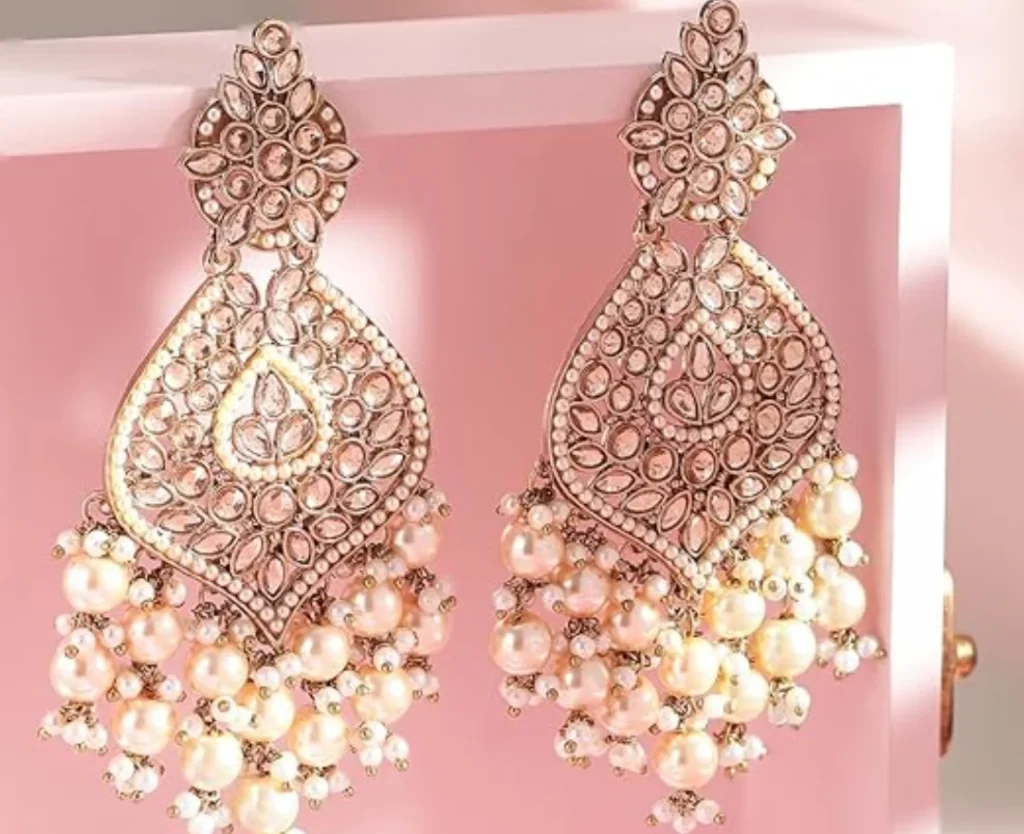
While traditional designs remain incredibly popular, showcasing intricate filigree and Kundan work, modern interpretations offer a fresh take on this classic. Contemporary Chandbalis might incorporate lighter materials or minimalist designs, appealing to a broader fashion sensibility. Their unique shape makes them instantly recognizable and highly coveted.
2. Jhumkas (Bell-shaped)
Perhaps the most iconic of all Indian earrings, Jhumkas are instantly recognizable by their charming bell-shaped design and the delightful jingle they make. They come in various sizes, from delicate mini-jhumkas perfect for daily wear to grand multi-tiered versions suitable for bridal ensembles. These versatile pieces are often embellished with pearls, beads, or intricate enamel work.
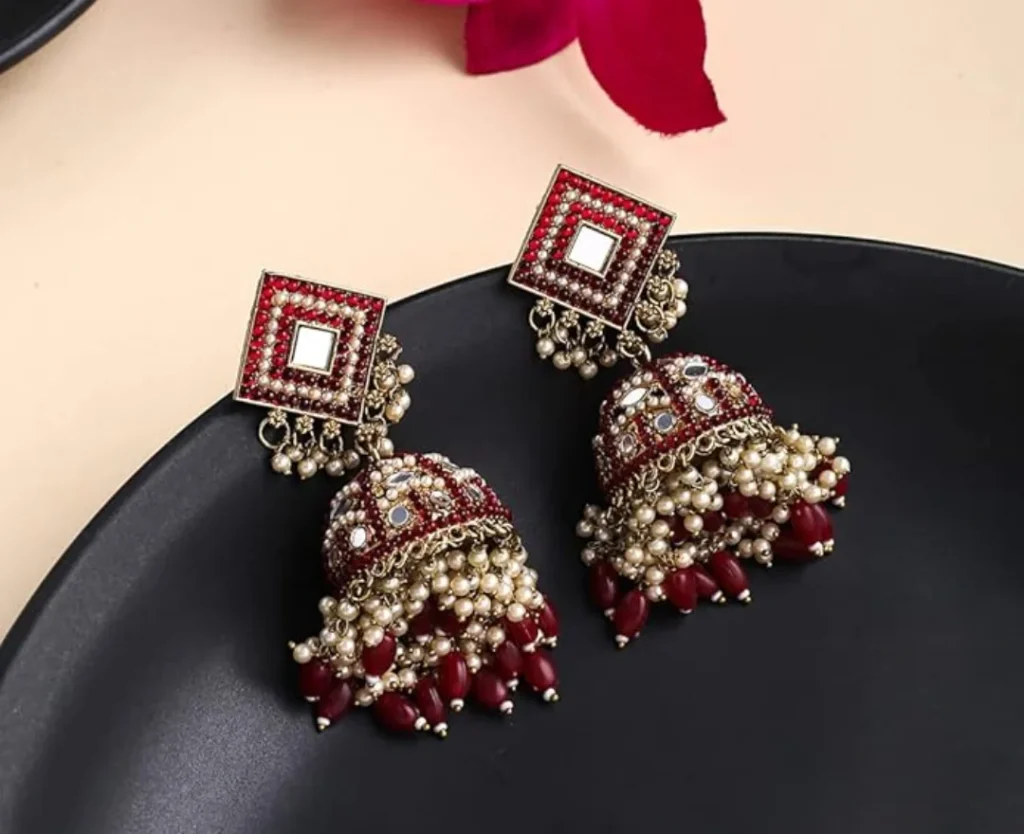
Jhumkas are a testament to the rich craftsmanship found across India, with regional variations adding to their immense appeal. If you’re fascinated by the sheer variety and want to explore their numerous styles in detail, don’t forget to check out our previous deep dive into the fascinating world of Jhumkas. That blog post offers a comprehensive look at their diverse forms and cultural significance.
3. Bali (Hoop Earrings)
While hoops are a universal jewelry staple, Indian ‘Bali’ earrings often feature unique embellishments, engravings, or traditional motifs that set them apart. These can range from simple, elegant gold hoops to more elaborate designs adorned with small charms or intricate patterns. They offer a blend of contemporary style with traditional Indian artistry.

Bali earrings are incredibly versatile, suitable for both casual and semi-formal occasions. Their circular form symbolizes completeness and continuity, making them a popular choice across various cultures within India. They transform a simple hoop into a statement piece, reflecting personal style and cultural appreciation.
4. Long Dangler Earrings
Cascading gracefully, long dangler earrings are designed to create a dramatic and elegant visual impact. These styles can feature multi-tiered designs, delicate chains, or threader styles that weave through the ear. They are perfect for adding sophisticated movement and sparkle to any ensemble, from traditional wear to modern fusion outfits.

Often adorned with a variety of gemstones, pearls, or intricate metalwork, long danglers draw attention to the neck and jawline. Their elongated form makes them a favored choice for evening events and celebrations where a touch of glamour is desired. They truly embody grace and grandeur in Indian jewelry.
C. Ear Cuffs/Climbers
Ear cuffs and climbers represent a modern trend in Indian jewelry, blending contemporary fashion with subtle traditional influences. These innovative designs extend elegantly up the ear, often featuring intricate patterns that mimic traditional motifs or abstract forms. They offer a unique way to adorn the ear without multiple piercings.
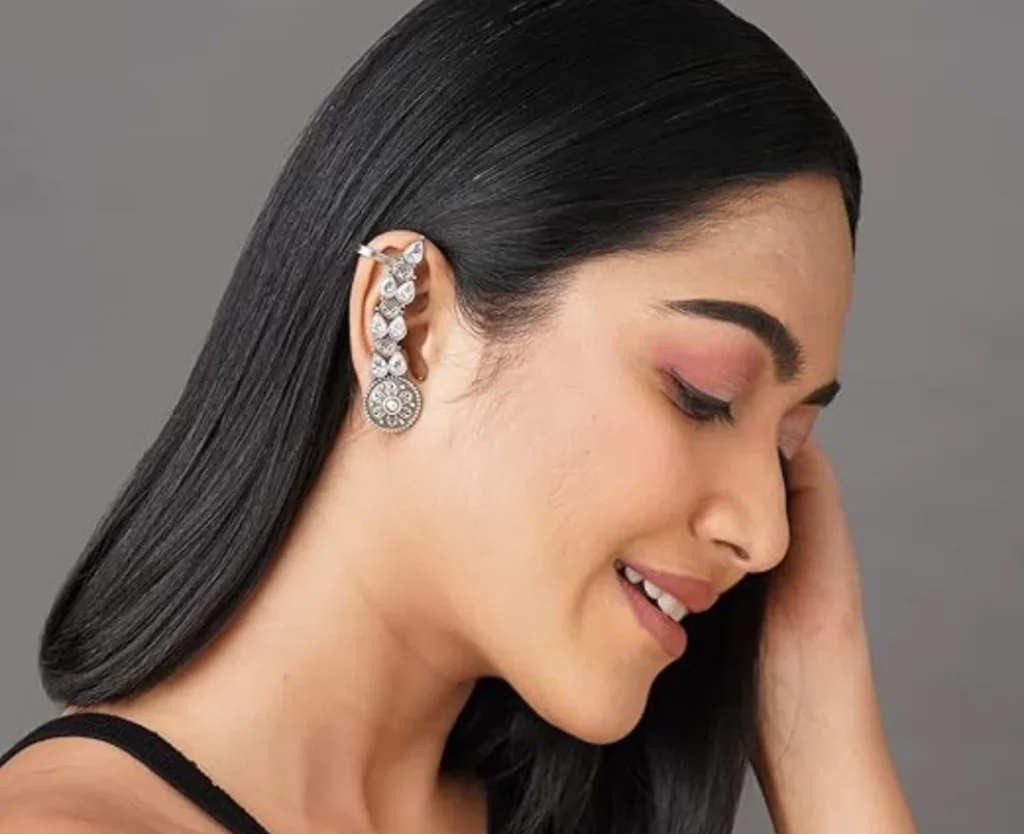
These stylish accessories provide a bold yet sophisticated statement, perfect for those looking to experiment with their look. They can be found in various materials, from minimalist silver to embellished gold-plated designs with stones, catering to diverse tastes. Ear cuffs and climbers are a testament to the evolving nature of Indian jewelry design.
D. Kaanphool (Ear Flower)
True to its name, ‘Kaanphool’ translates to ‘ear flower’ and refers to large, elaborate earrings designed to cover a significant portion of the earlobe. These magnificent pieces are often intricately crafted, featuring detailed patterns and sometimes extending upwards with chains that can be attached to the hair. They embody a grand, traditional aesthetic.
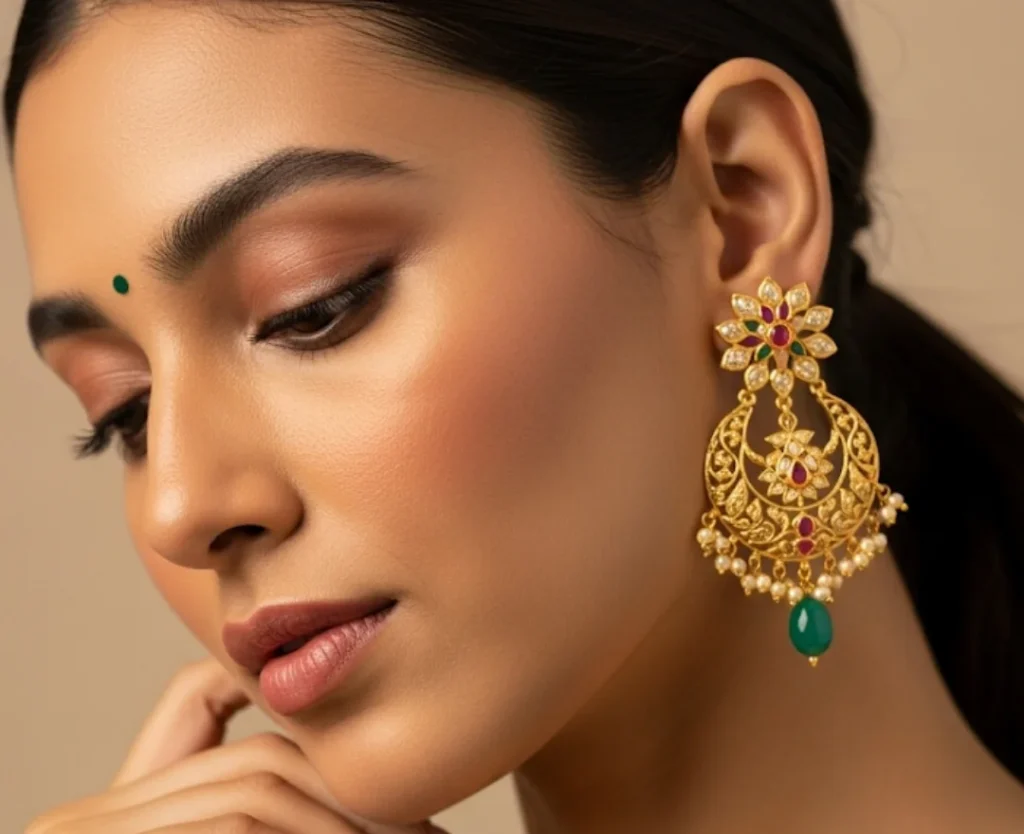
Kaanphool earrings are frequently combined with Jhumkas or other drops, creating a stunning and opulent look, especially for bridal or festive occasions. Their substantial size and detailed artistry make them a focal point of any traditional Indian ensemble. They are a true celebration of intricate craftsmanship and rich cultural heritage.
E. Baali (Large traditional hoops)
Distinct from the smaller, more contemporary ‘Bali’ hoops, ‘Baali’ refers to substantial traditional hoops that are often larger in diameter and feature more intricate workmanship. These pieces are designed to make a bold statement, reflecting a classic and timeless Indian jewelry aesthetic. They are frequently seen in traditional attire.
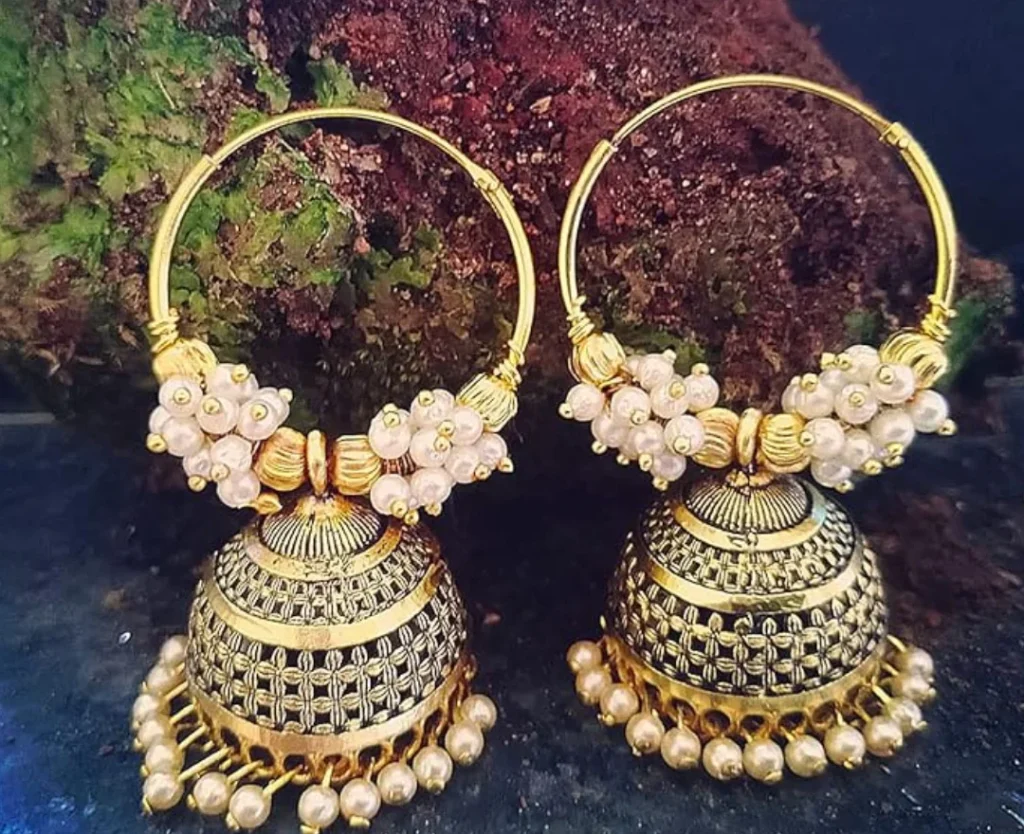
Baali earrings can be plain gold or silver, or heavily embellished with engravings, filigree work, or even small dangling elements. Their impressive size and detailed craftsmanship make them a beautiful and powerful choice for those seeking a truly authentic traditional look. They are a testament to enduring design.
F. Kundan Earrings
Originating from Rajasthan and popularized during the opulent Mughal era, Kundan jewelry is a hallmark of royal grandeur and intricate artistry. This technique involves setting uncut diamonds or glass stones into a gold foil base, creating a dazzling effect that reflects light beautifully. The reverse side often features vibrant Meenakari enamel work.
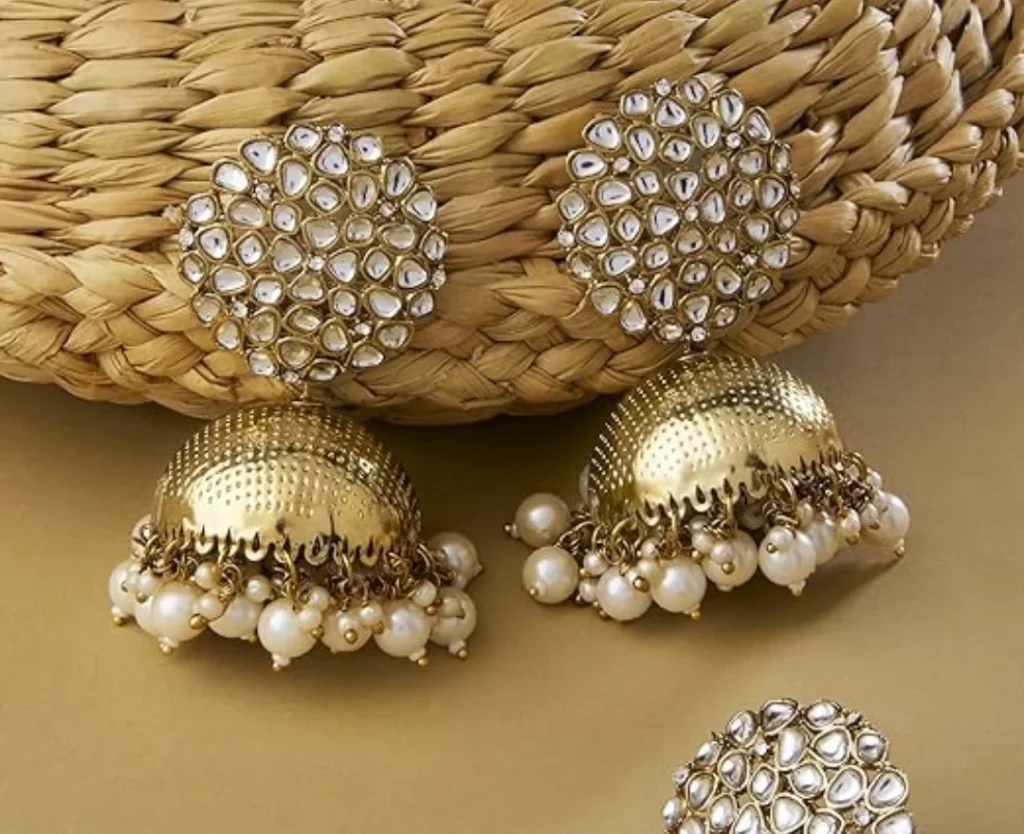
Kundan earrings are highly sought after for bridal wear and grand festive occasions, exuding an old-world charm and unparalleled luxury. Each piece is meticulously handcrafted, making it a unique work of art that carries centuries of tradition. They are a symbol of heritage and timeless elegance.
G. Polki Earrings
Similar to Kundan, Polki earrings feature uncut diamonds in their natural, rough form, giving them a raw, earthy, yet incredibly luxurious appeal. Unlike faceted diamonds, Polki diamonds are used as they are found, preserving their organic shape and unique sparkle. This gives each piece a distinct character.
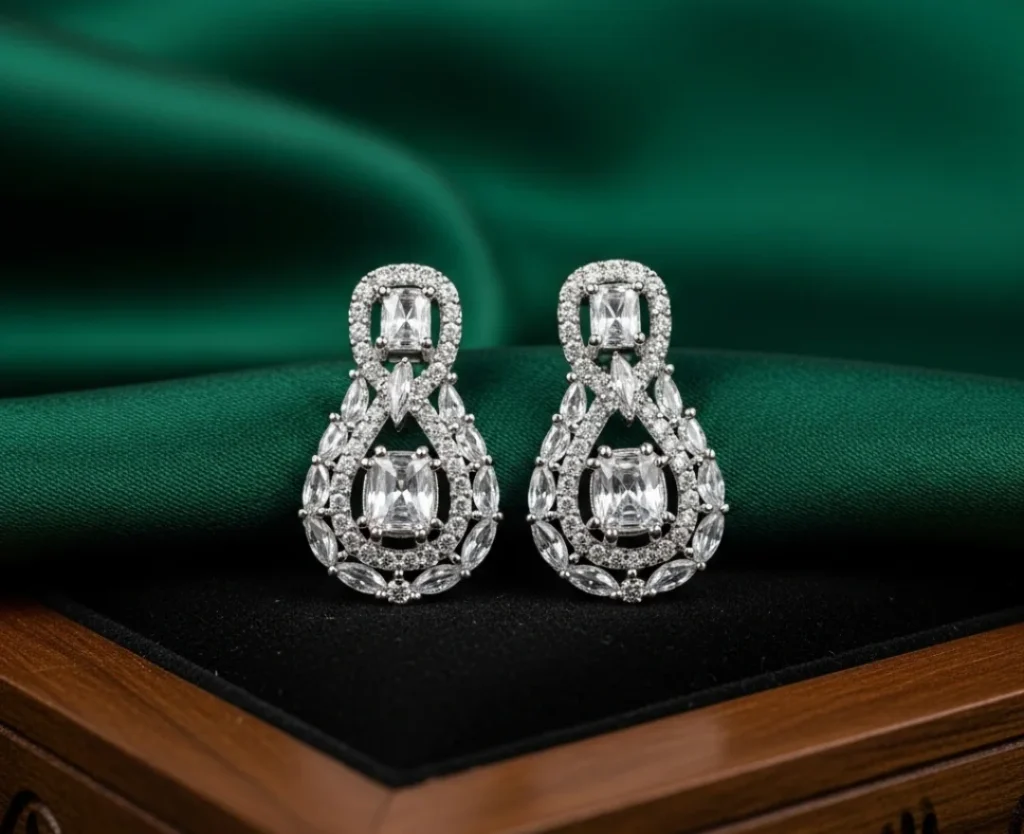
Polki jewelry is highly prized for its authenticity and vintage charm, often set in gold to enhance its natural beauty. These earrings are a popular choice for traditional Indian weddings and high-end events, offering a blend of traditional aesthetics and unparalleled opulence. They are a true investment in heritage.
If you are confused between polki and kundan jewellery you can read our detailed guide to make a better decision according to your need.
Classification by Material and Craftsmanship
The material and craftsmanship employed in Indian earrings are as diverse as their designs, reflecting the regional availability of resources and specialized artisan skills. This variety ensures that there is a perfect pair of earrings for every taste and budget, from precious metals to handcrafted natural materials.
Each material brings its own unique texture, weight, and aesthetic to the final piece, contributing to the vast array of styles available. The intricate techniques used by artisans further elevate these materials into wearable art. This section explores the most common materials and craftsmanship techniques.
- Gold Earrings: From traditional yellow gold, deeply rooted in Indian culture and often seen in intricate filigree work, to modern white and rose gold variations that appeal to contemporary tastes.
- Silver Earrings: Popular in oxidized, sterling, and tribal silver jewelry, offering a versatile range from rustic and antique looks to sleek, contemporary designs. Silver is often more affordable and equally stunning.
- Gemstone Earrings: Adorned with precious stones like emeralds, rubies, sapphires, and diamonds, as well as a vibrant array of semi-precious stones such as amethyst, topaz, and garnet, adding bursts of color and sparkle.
- Pearl Earrings: Featuring lustrous Basra pearls, known for their unique sheen, or cultured pearls, adding a touch of classic elegance and timeless sophistication to any outfit.
- Lac (Lacquer) Earrings: Lightweight and colorful, often originating from Rajasthan, these earrings are made from lac and adorned with intricate patterns and mirror work, known for their vibrant hues and traditional charm.
- Terracotta Earrings: Eco-friendly and handcrafted from baked clay, these unique earrings are often painted with traditional or modern designs, offering an earthy and artistic appeal. They are lightweight and comfortable for daily wear.
- Thread/Fabric Earrings: A contemporary trend, these are lightweight, colorful, and offer a unique texture, often incorporating embroidery, beads, or tassels. They are perfect for a bohemian or casual chic look.
For those who adore the beauty of artificial jewelry but worry about its longevity, understanding proper care is crucial. Artificial jewelry can retain its luster for years with the right maintenance and storage. It’s an excellent way to enjoy diverse styles without the cost of precious metals.
We highly recommend reading our comprehensive guide on how to prevent artificial jewelry from tarnishing. It’s packed with practical tips and tricks to keep your beautiful pieces sparkling for years, ensuring your fashion investments last. This guide will help you preserve their beauty.
Traditional Indian Earrings
India’s vast geographical and cultural landscape has given rise to an incredible array of regional earring styles, each reflecting local traditions, craftsmanship, and aesthetic preferences. These traditional Indian earrings are often deeply intertwined with the history and customs of the area. They offer a unique glimpse into the diverse heritage of Indian jewelry.
From the intricate temple jewelry of the South to the vibrant enamel work of Rajasthan, each region boasts a distinctive approach to earring design. Exploring different types of Indian earrings across these regional variations is like embarking on a cultural tour through India’s rich artistic legacy. This section highlights some of the most prominent regional styles.
A. South Indian Earrings
South Indian earrings are renowned for their exquisite Temple Jewelry, a prime example of traditional Indian earrings deeply rooted in religious and cultural motifs.
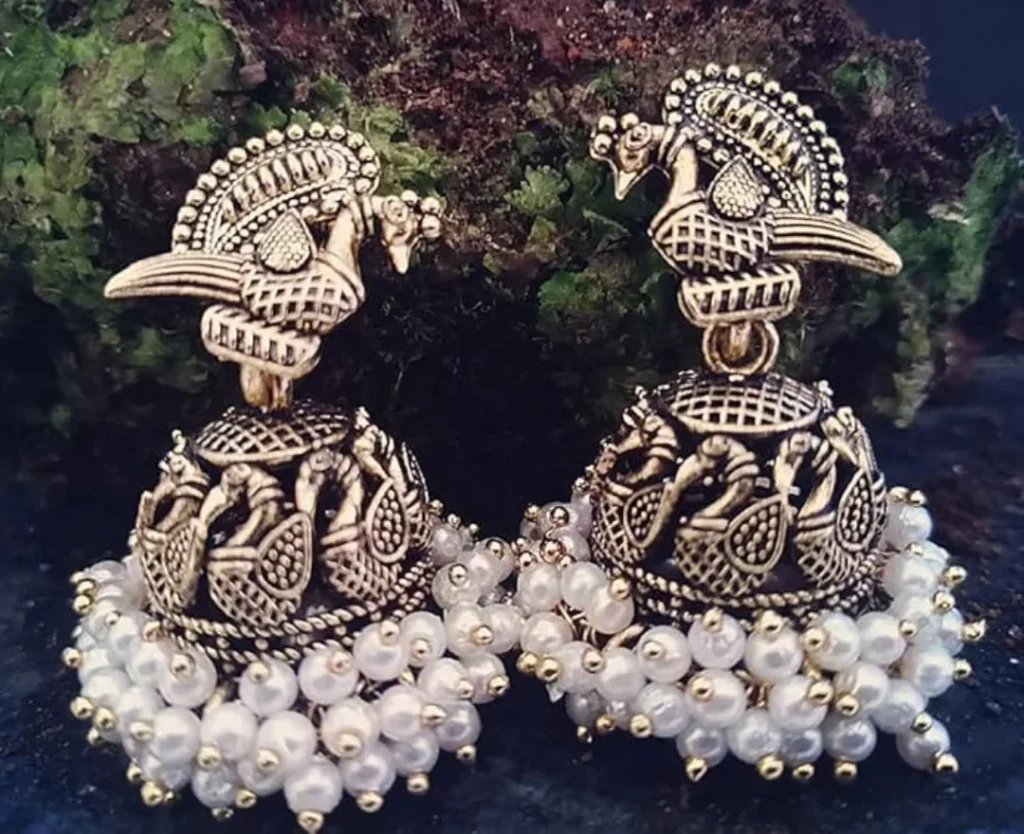
These pieces often feature intricate designs of deities, peacocks, or floral motifs, meticulously crafted in antique gold and adorned with vibrant rubies and emeralds. They are considered auspicious and are frequently worn during religious ceremonies and weddings.
Beyond Temple Jewelry, South India also boasts other unique styles like ‘Kasu Malai’ (coin necklaces) which frequently come with matching earrings, showcasing the region’s love for gold and elaborate designs. The craftsmanship is highly detailed, reflecting centuries of tradition passed down through generations. These pieces are truly a legacy.
B. Rajasthani Earrings
Rajasthan, the land of kings, is famous for its opulent jewelry styles, including Kundan, Polki, and the vibrant Meenakari (enamel work). Rajasthani earrings are known for their rich colors, elaborate designs, and the use of precious and semi-precious stones, reflecting the grandeur of its royal past. They often incorporate traditional motifs like peacocks and flowers.
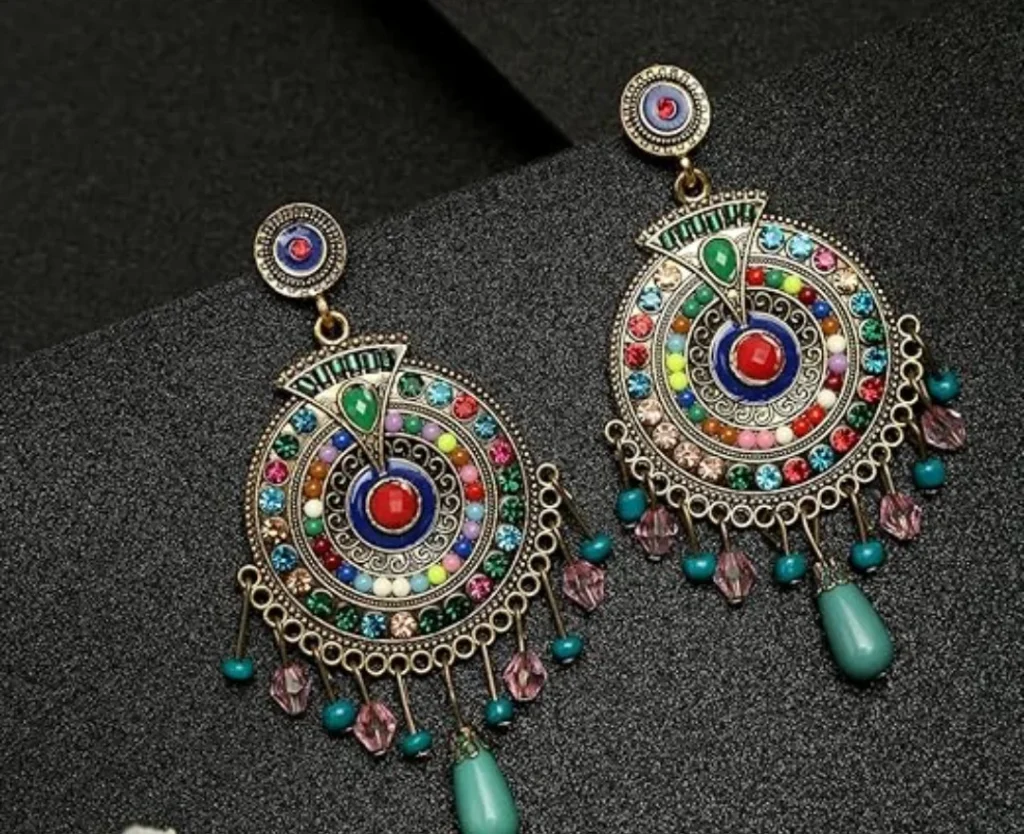
The ‘Nath’ (nose ring), a significant bridal accessory in Rajasthan, is often beautifully paired with complementary earrings, creating a cohesive and stunning bridal look. The intricate detailing and vibrant hues make Rajasthani earrings a favorite for festive occasions and weddings. They are truly works of art.
C. Gujarati Earrings
Gujarati earrings are characterized by their intricate patterns, often incorporating mirror work, colorful beads, and detailed filigree. These designs are typically bold and celebratory, reflecting the vibrant culture and festive spirit of Gujarat. They are often lightweight despite their elaborate appearance, making them comfortable to wear.
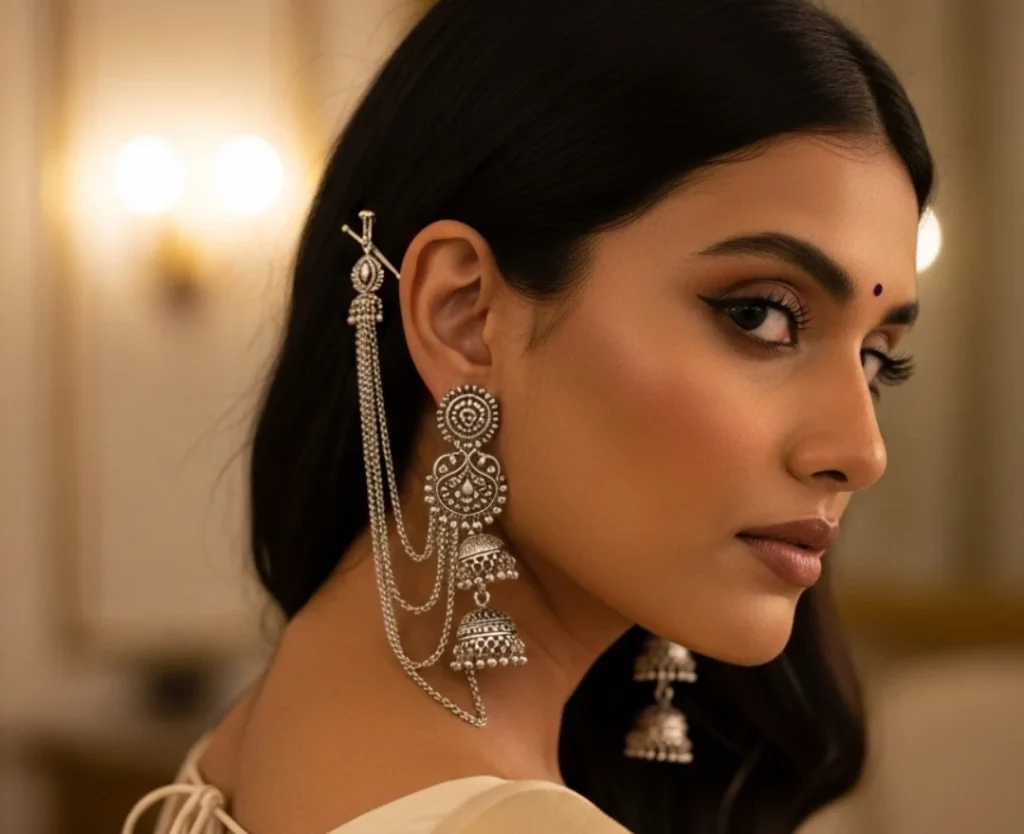
Traditional Gujarati earrings, such as the ‘Kaan’ or ‘Jhumka’ styles, are often adorned with small ghungroos (bells) that create a gentle chime with movement. These pieces are popular for Garba and other traditional dances, adding to the festive atmosphere. They are a true reflection of the region’s joyous traditions.
D. Kashmiri Earrings
Kashmiri earrings are distinct for their unique designs, often reflecting the serene beauty of the region. The ‘Dejhoor’, a piece of traditional Indian earrings worn by Kashmiri Pandit women, is particularly significant. It is a distinctive long, dangling ornament, often worn through a piercing in the upper ear, symbolizing marital status.
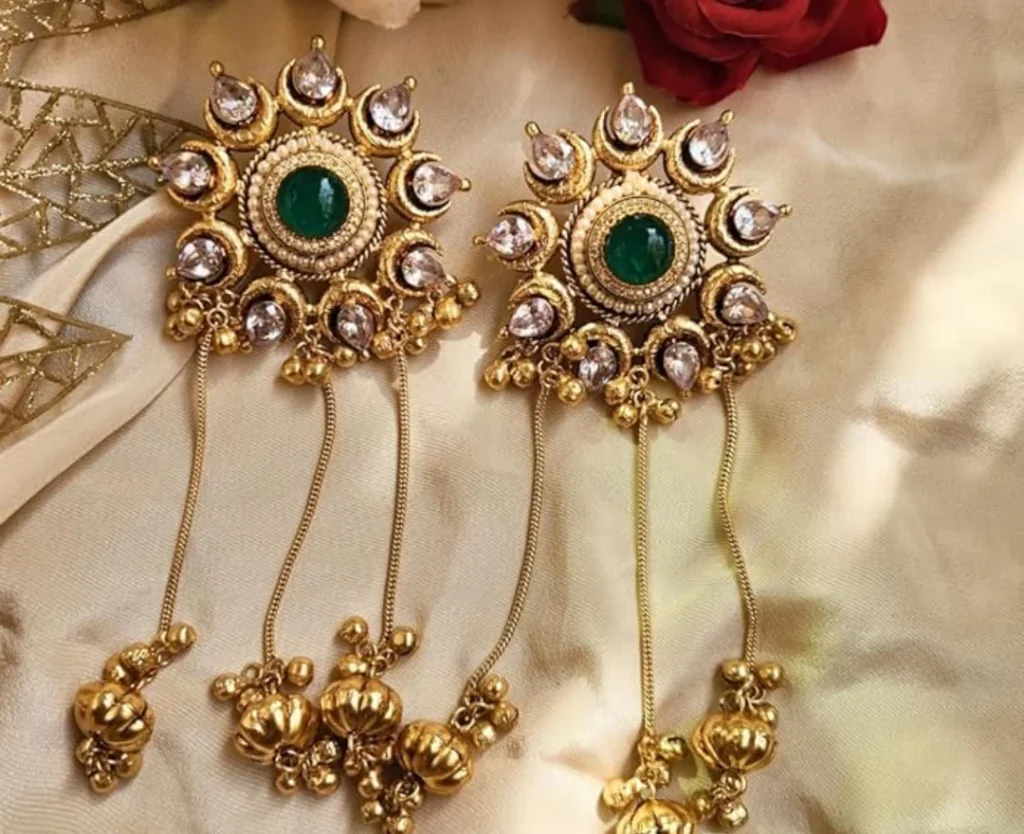
These earrings typically feature intricate gold or silver work, sometimes adorned with pearls or precious stones. Kashmiri jewelry often has a delicate yet elaborate appearance, reflecting the fine craftsmanship of the valley. They are not just ornaments but also carry deep cultural and symbolic meaning.
E. Tribal Earrings
From various indigenous communities across India, tribal earrings boast distinctive styles that are deeply rooted in ancient traditions and unique aesthetics. These pieces are often crafted from raw silver, brass, beads, and natural materials like shells, bone, or wood. They possess a rustic finish and bold, earthy designs.
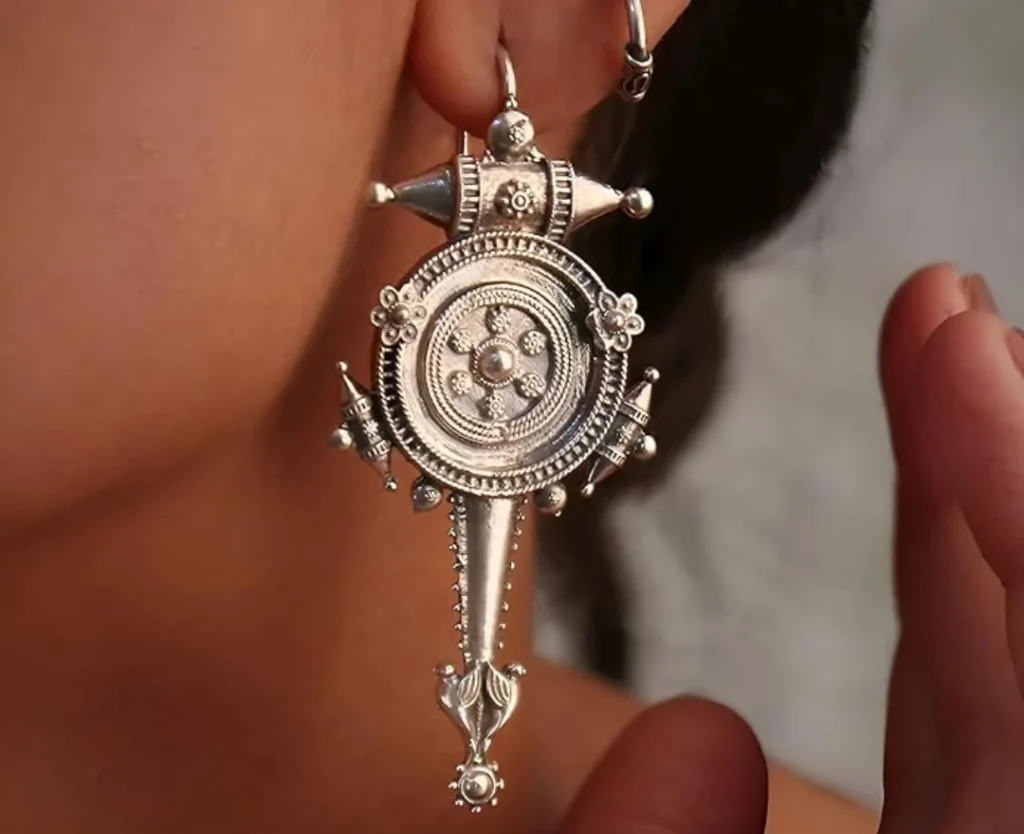
Tribal earrings are characterized by their raw beauty, geometric patterns, and often larger, more substantial forms. Each piece tells a story of the community’s heritage, beliefs, and connection to nature. They are not just jewelry but powerful cultural statements, reflecting the rich diversity of India’s indigenous artistry.
Occasion-Based Selection
Choosing the right earring often depends on the occasion, as different styles are suited for various settings and levels of formality. The vast selection of Indian earrings allows for perfect pairing with any outfit or event. Understanding these nuances helps in making a confident and stylish choice.
Whether you are attending a casual gathering, a grand wedding, or a formal event, there is an Indian earring designed to complement your look. The versatility of these pieces makes them indispensable in any jewelry collection. This section provides guidance on selecting earrings for specific occasions.
- Everyday Wear: For daily comfort and subtle elegance, simple studs, small hoops, or lightweight danglers are ideal. They add a touch of sparkle without being overwhelming.
- Festive Occasions: Vibrant Jhumkas, colorful Lac earrings, or elegant Chandbalis are perfect for celebrations. These pieces add a festive flair and complement traditional Indian attire beautifully.
- Weddings and Bridal Wear: Grand Kundan, Polki, or elaborate Temple Jewelry earrings are the go-to choices. These opulent pieces are often paired with matching sets, creating a stunning bridal look.
- Formal Events: Sophisticated drop earrings with gemstones or elegant gold designs are suitable for formal gatherings. They add a touch of refined glamour and complete a polished ensemble.
FAQs
How do I choose earrings for my face shape?
Oval faces suit most styles, while round faces benefit from elongated designs. Square faces look best with curved earrings, and heart-shaped faces should choose wider-bottom styles.
What are Indian style earrings called?
Indian style earrings are commonly called “Jhumkas,” “Chandbalis,” “Studs,” “Danglers,” or “Tops.” Jhumkas are bell-shaped, while Chandbalis resemble crescent moons. Traditional designs often feature intricate gold, silver, or Kundan work.
Are heavy traditional earrings uncomfortable?
Modern lightweight versions using resin or hollow metal make heritage designs wearable. For weddings, practice wearing them beforehand and use silicone comfort backs.
Can I wear Indian earrings with Western outfits?
Absolutely! Pair small jhumkas with blazers or chandbalis with off-shoulder dresses for fusion looks. The key is balancing proportions and metal tones.
Which Indian earrings are the most attractive?
Jhumkas (bell-shaped) and Chandbalis (crescent moon) are timeless favorites, while Kundan studs and temple danglers add elegance for weddings and festivals. For daily wear, delicate hoops or pearl studs work best.
Conclusion
The world of Indian earrings is truly boundless, offering an incredible array of designs, materials, and cultural narratives that captivate and inspire. From the intricate artistry of Kundan to the rustic charm of tribal silver, each pair tells a unique story of heritage and craftsmanship. This diversity ensures that there is a perfect earring for every individual and every occasion.
While fashion trends may evolve and new styles emerge, the timeless appeal and profound cultural significance of Indian earrings continue to captivate hearts worldwide. Whether you’re drawn to traditional grandeur or contemporary chic, there’s an Indian earring out there waiting to adorn you and become a cherished part of your personal style journey. They are more than just jewelry; they are a legacy.

